Hi everyone,
I've been working with sourdough for months with mixed results; I'm finally getting more consistently better loafs, but am hoping for some additional pointers.
I was gifted Hamelman's Bread, which has been my intro to breadmaking. All last year, I worked through his yeasted breads with success. This year, I moved on to levain breads - between learning to make a starter for the first time and trying to figure out how to use another gift of an Ankarsrum mixer, I think I might've juggled too many new variables at once. For the past several bakes, I've been working with his Vermont Sourdough nearly exclusively as I try to figure out proper technique (recipe at King Arthur).
Following the recipe as-is in the book has generally resulted in loaves that are a bit too dense and have a slight gummy quality. So, I've decided to push bulk fermentation further to see if that helps.
Hamelman calls for a 2.5 hour bulk ferment. Last week, I decided to push that, feeling that my loaves over the past several months have consistently been underfermented and underproofed. I did the following (using KA AP flour):
- Mixed (4 minutes at 1 o'clock on the Ankarsrum)
- Fermentolyzed for 1 hour
- Mixed again (8 minutes at 3 o'clock on the Ankarsrum)
- The dough felt a little loose still, so I did a stretch and fold. I then did stretch and folds about every 50 minutes during a bulk fermentation of about 4 hours. I saw bubbles on the sides and bottom, and it had risen a bit, so decided to call it here.
- I then pre-shaped and shaped into 2 loaves. I did two different things with the loaves. I allowed Loaf 1 to rise for about an hour before baking. I put Loaf 2 in the fridge immediately after shaping (and then baked straight from the fridge the following morning).
Here are the results. Loaf 1 (no cold retard):
It spread out more and was flatter than Loaf 2. It also was a good deal denser and slightly gummy.
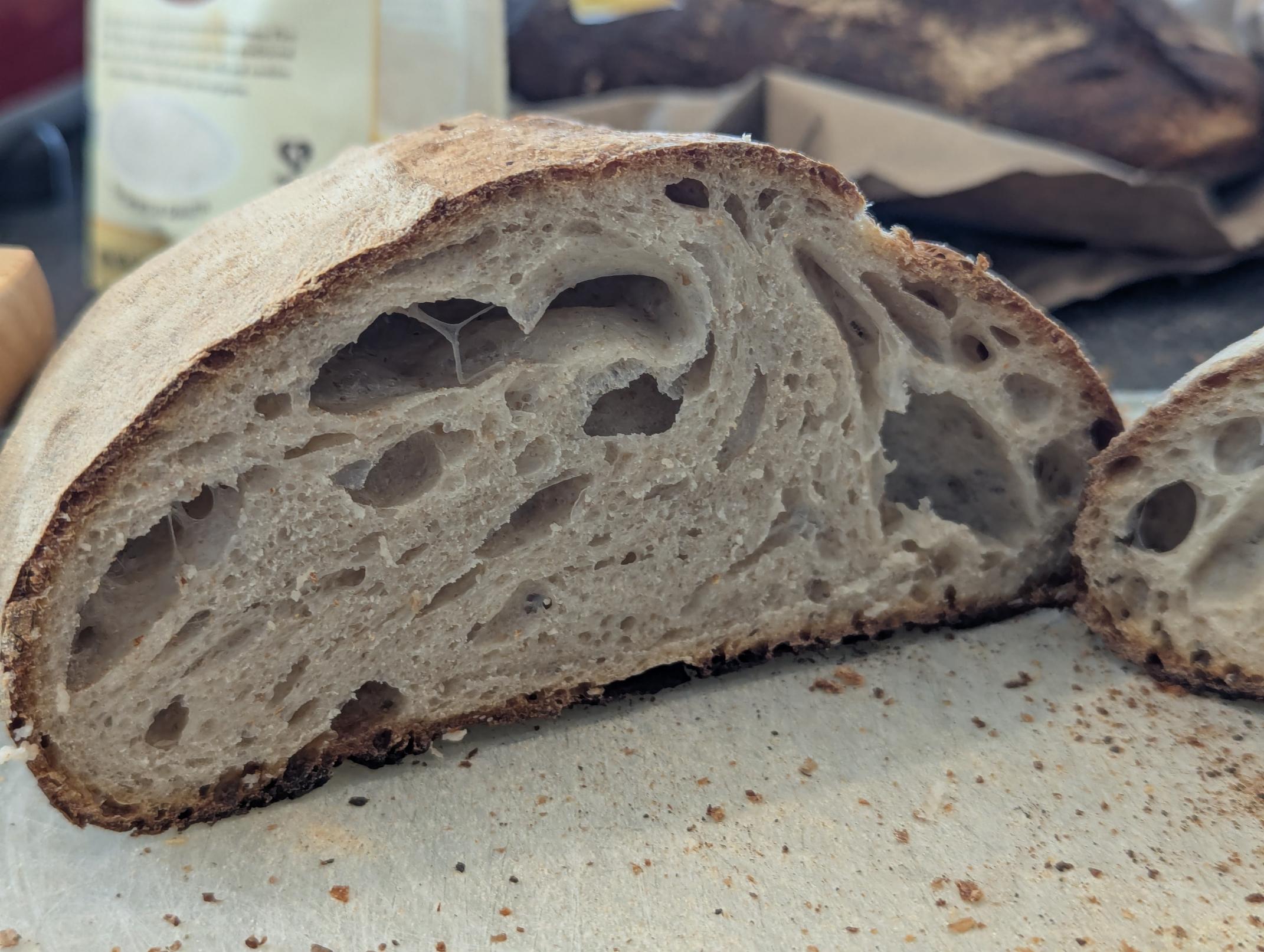
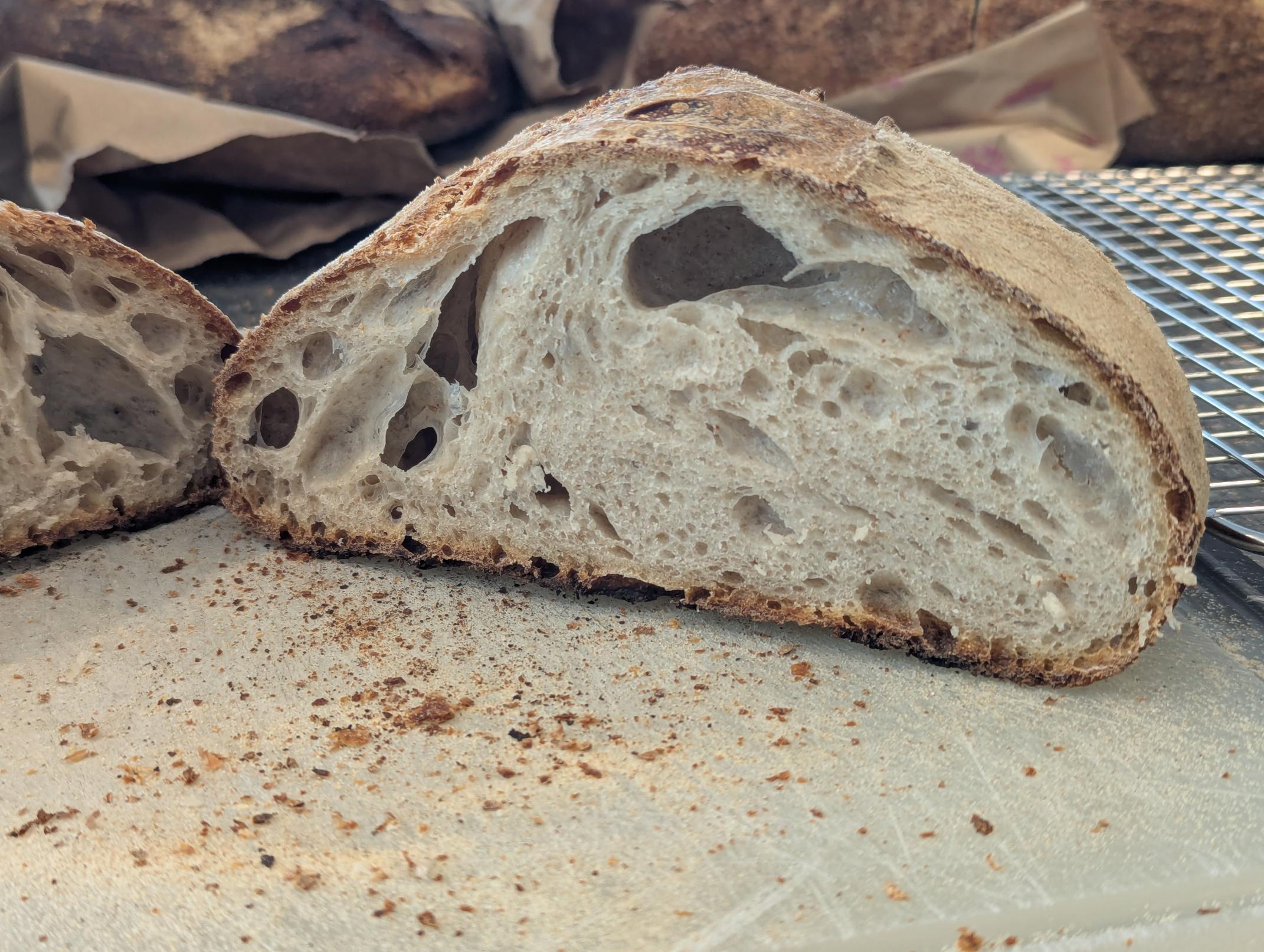
And here's Loaf 2 (this one had the overnight cold retard):
It rose quite a bit more, though perhaps with a slight bulbous quality as the rise is concentrated more at the middle than at the ends.
Texturally, this seemed much much better, though still perhaps a bit too dense? It was definitely more "bread-like" texturally, though given my past experience, I was on the fence regarding whether this bread was just slightly gummy or just had the appropriate amount of chew. It was a clear winner over Loaf 1, in any case.
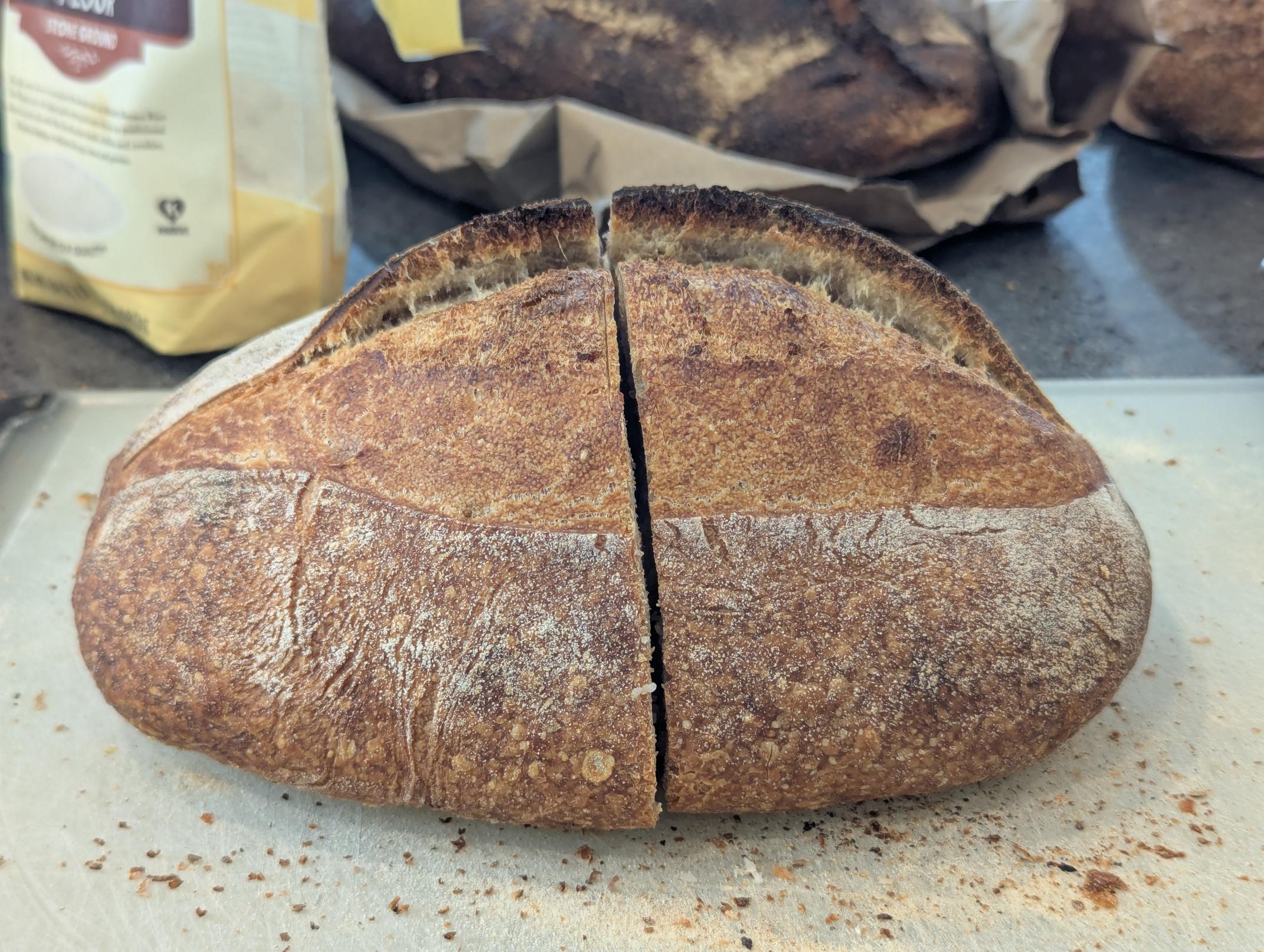
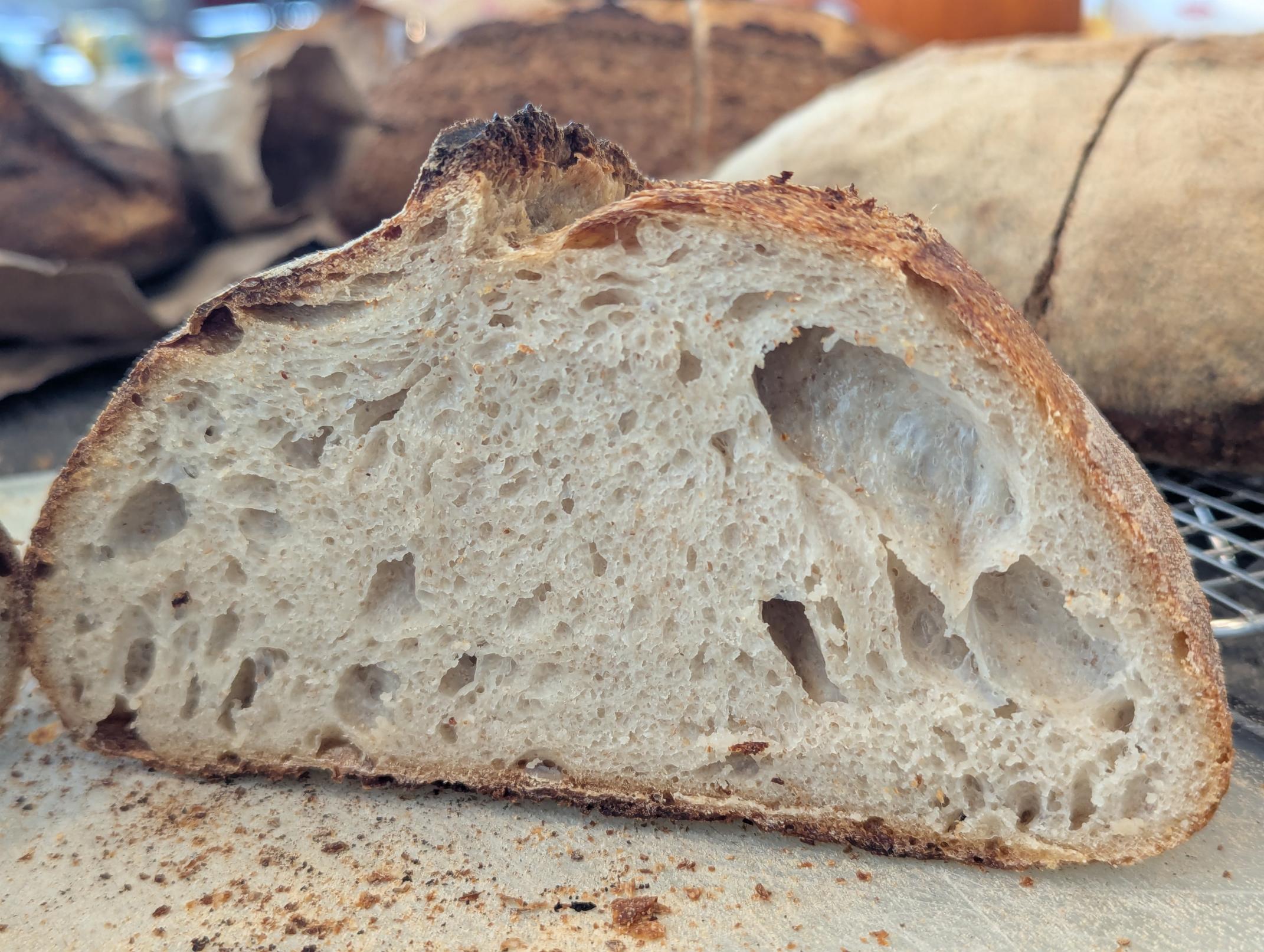
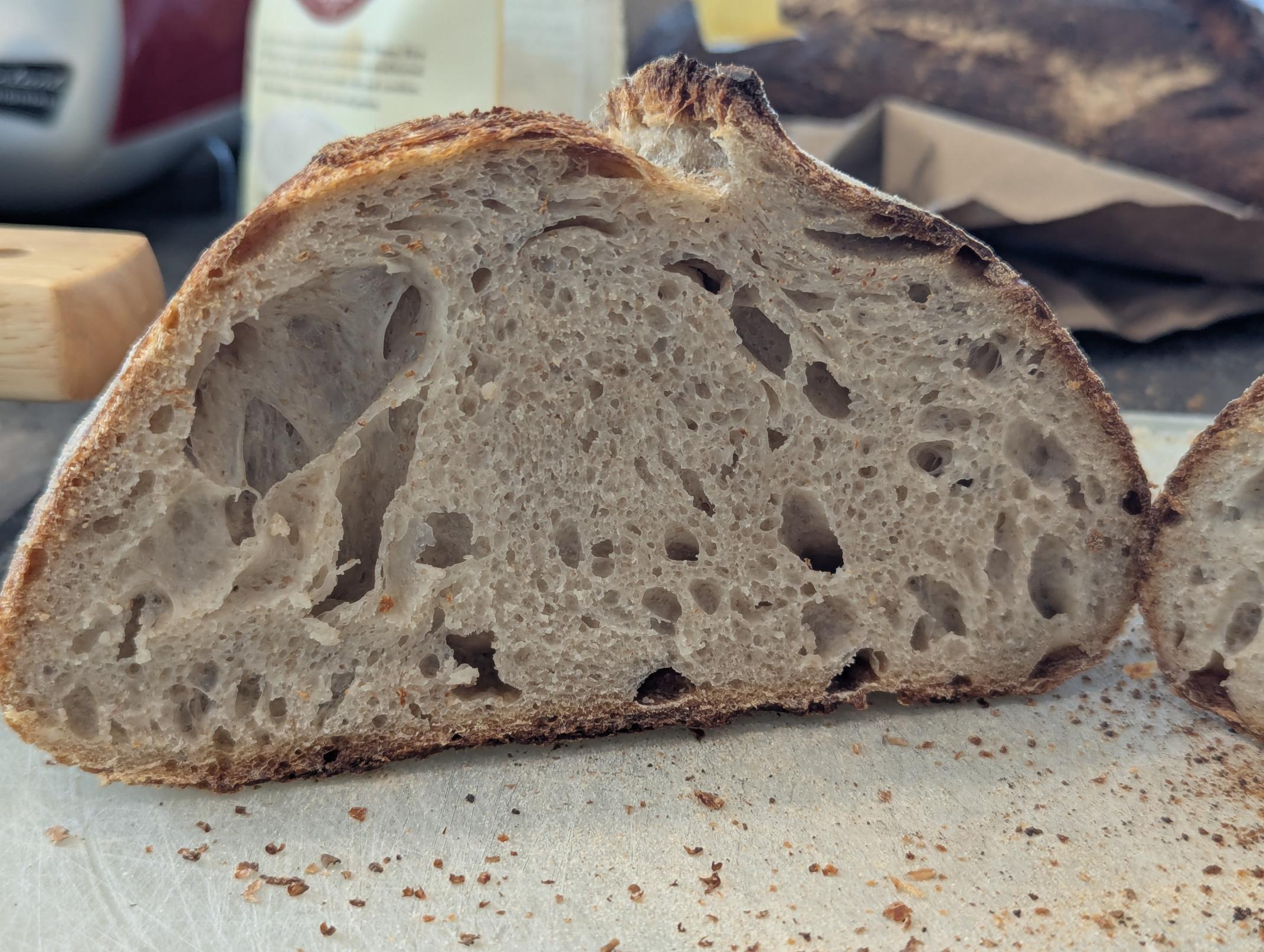
I tried to optimize the process of Loaf 2. Because I thought it might be a touch too dense and not quite open enough, I decided to do fewer stretch and folds and bulk ferment 30 minutes longer.
So, for Loaf 3:
- Mixed (4 minutes at 1 o'clock on the Ankarsrum)
- Fermentolyzed for 1 hour
- Mixed again (10 minutes at 3 o'clock on the Ankarsrum; I mixed a couple minutes longer this time).
- I did three stretch and folds over a bulk fermentation of 4.5 hours.
- I pre-shaped, shaped, and put straight into the fridge. Then the next morning, I baked straight from the fridge.
Loaf 3 felt different. In fact, during shaping, it felt much jigglier, looser, and stickier than the other two loaves. For that reason, it was actually harder to shape than Loaves 1 and 2.
Here are the results of Loaf 3. (I baked two loaves, as you can see, but am focusing on the one that had better oven spring):
Loaf 3 had a much better rise, and a more consistent one across the whole loaf without the bulbous rise of Loaf 2. Loaf 3 also has this row of what looks like 3 bubbles on the edge of the crust. The crumb has more medium-to-large holes in it, but also it looks like it has some tunneling. The good news is that I would not describe the texture as gummy or dense - but if anything, I might prefer the more closed crumb of Loaf 2!
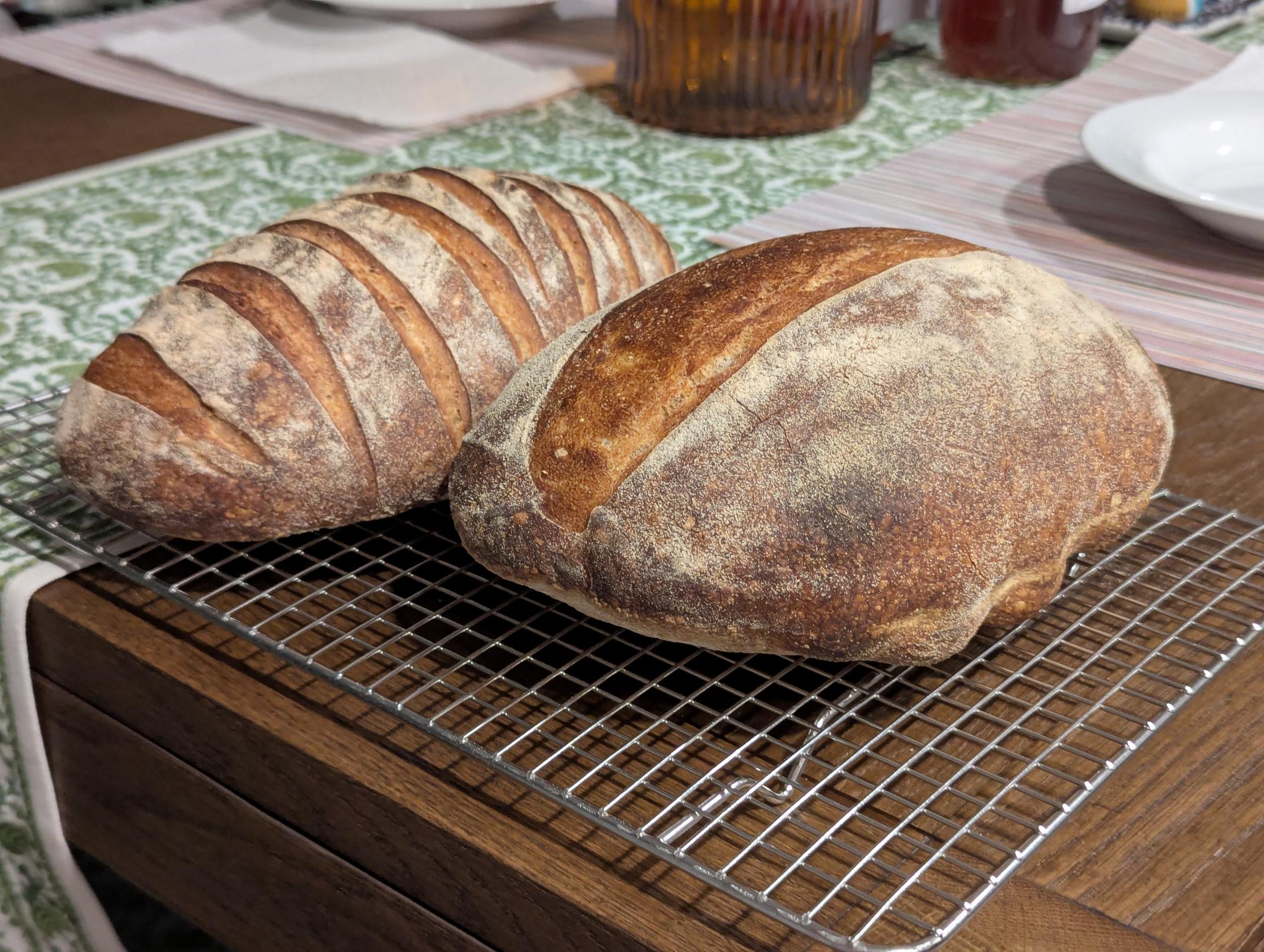
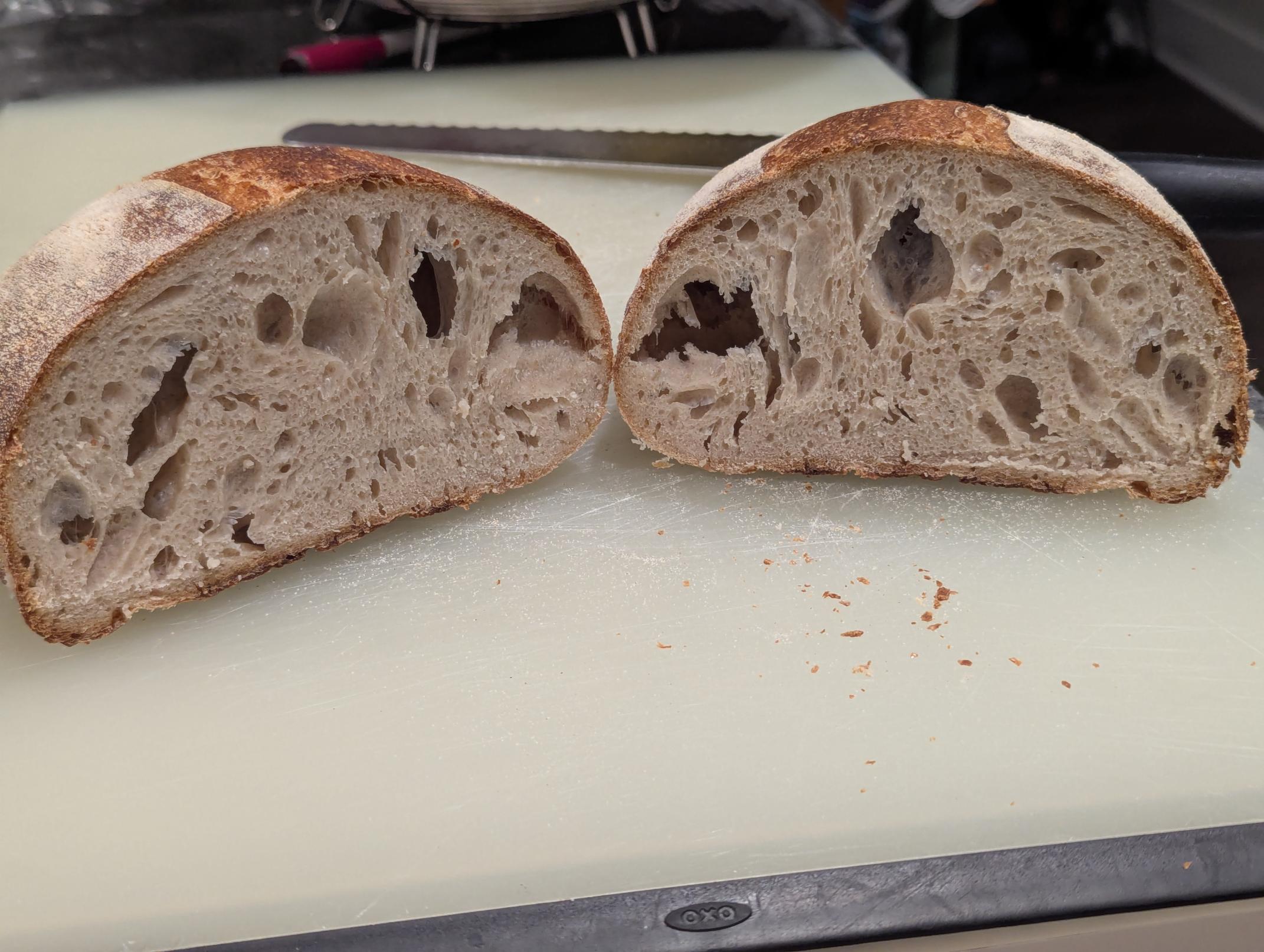
Any observations would be greatly appreciated! I've been going it alone for a few months now, and I think I need an extra pair of eyeballs to help evaluate how close I am and what I need to do going forward. My boyfriend tells me every loaf is good, which is encouraging but not much help :)
- Does it look like I need to be pushing the bulk ferment even more? Or do my issues look more like a shaping or gluten development issue?
- I'm a little wary of the fact that I've had to push bulk ferment longer than Hamelman suggests, given that he gives exact temperatures in the book (and I bought a proofing box to keep me at the specified temps). Pushing bulk fermentation 1.5-2 hours past his time window makes me think I've gotta be doing something wrong. I mean, the loaves are much better for it, but it feels wrong to have to adjust the recipe to that degree. Or is this just a normal part of adapting a recipe to a home conditions?
- One other consideration I've had is the possibility of a weak starter. Hamelman has been my first experience with sourdough, so I've been maintaining his 125% liquid levain over the last several months as my starter, which he also calls for in the levain build for this recipe specifically. Before a bake, I take the starter out of the fridge a few days in advance and I feed it about every 12 hours (at a 1:2:2.5 ratio). It does not quite double at peak, but my understanding is that at such a high hydration, I should not expect to see a literal doubling? It's jiggly, bubbly, and has a smattering of clusters of tiny soap-like bubbles at peak.
You are doing fine and you seem to be learning quickly, all to the good. You might try changing fewer things at once, because you can get mislead about what change made which difference.
All the loaves have big-ish cavities that look to me like shaping issues. The dough needs to be degassed, free from big bubbles, and able to merge with itself.
The first loaf looks to me underfemented and also underbaked. A longer bake might have browned the top too much and that tells us that you should lower the oven temperature and bake for a longer time. If you have a probe-style thermometer, use it to check the interior after you think the bake is done. For these kinds of breads, you want to see the temperature around 210 deg. F (though 207 and up will be all right). Breads that contain a lot of water may need longer baking at a lower temperature after this so don't use the temperature as a definitive guide. But if it's in the low 200s or lower, you can expect a damper, gummy loaf.
It's really hard to overferment seriously in home baking. Usually the worst that will happen is that the crumb will come out with an even texture, even when well expanded.
Why did I write that the first loaf seems underfermented and underbaked? Look at the crumb, in between the large cavities. The pores are very small, barely visible. That's suggestive of underfermentation. The appearance also looks gummy to me, which is a sign of underbaking and also possibly of underfermentation.
In the second loaf's picture you can see the pores are larger - again, ignore the big cavities and tunnels. That indicates more fermentation. The dough is loosening up an gaining more volume.
The third loaf's crumb shot doesn't seem to have the pores open any more than the second, and maybe less so. There are even more large cavities, but these cavities that are related to shaping technique aren't the kind of texture one is looking for. If you like larger cavities, they need to grow as the loaf proofs and expands, not because the dough didn't stick to itself during shaping.
Don't worry at all about not precisely hitting the times and temperatures in some book, no matter how well-regarded the author is. You are in your kitchen with your flour and water and starter, your proofer may be calibrated differently than his, your oven is certain to be calibrated differently and to work differently, and so on. The mineral content of of your water is almost certainly different and that can make a real difference.
Your job as you learn is to discover how to adapt other people's recipes to work for you. You'll get there.
About retarding in the fridge. The dough will take some time to cool down before fermentation slows to a crawl. I use a rule of thumb that it takes about an hour. So if you expect to have fermentation complete in 2 hours, put the dough into a fridge after one hour. The larger the dough mass, the longer the time to cool all the way through.
TomP
Thanks so much for your detailed feedback, TomP. That's exactly why I was hoping someone else could take a look - I was so convinced that fermentation was the variable I needed to nail down and hadn't really considered that I could be underbaking, or that shaping could be a bigger factor than I was assuming in the bread's textural issues. I knew I had a tunneling problem and assumed the issues with my crumb had to primarily be underfermentation or underproofing to the exclusion of other factors (and thanks for pointing out how and where to read underfermentation in my own loaf - it's much easier to understand it when its your own work vs. scanning scattered photos online).
I'll look up shaping techniques. I've been reluctant to be too "rough" to the dough and perhaps have been too gentle.
I do have a probe thermometer and will monitor on the next bake to make sure I'm hitting my temps. As you pointed out, the color might be tricking me - I thought I was getting nicely browned loaves, so I hadn't properly considered the possibility of underbaking.
Thanks again!
Hi,
I have all three editions of Hamelman's Bread. Editions one and two have the hydration of Vermont Sourdough at 65%, however, in edition three he changed it to 70%. I've reverted back to 65% as it is much better crumb and volume. I also alternate between 10% whole wheat and 10% whole rye. Apart from the taste difference that there is little difference in the dough and finished bread structure.
I only mix 1500 gram of dough at a time, so I mix by hand. Also, final dough temperature is important. I bake straight through and never retard the dough unless I'm called away.
Hope this helps.
Gavin
Awhile back, Tom posted a link to a shaping technique called the "caddy clasp". It is simple and works well. I use the "double" for both free-standing loaves and panned sandwich breads and am happy with the resulting crumb.